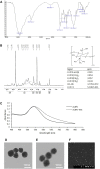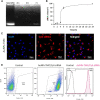Trimethyl-Chitosan Coated Gold Nanoparticles Enhance Delivery, Cellular Uptake and Gene Silencing Effect of EGFR-siRNA in Breast Cancer Cells
- PMID: 35517864
- PMCID: PMC9065351
- DOI: 10.3389/fmolb.2022.871541
Trimethyl-Chitosan Coated Gold Nanoparticles Enhance Delivery, Cellular Uptake and Gene Silencing Effect of EGFR-siRNA in Breast Cancer Cells
Abstract
Purpose: Despite the promising therapeutic effects of gene silencing with small interfering RNAs (siRNAs), the challenges associated with delivery of siRNAs to the tumor cells in vivo, has greatly limited its clinical application. To overcome these challenges, we employed gold nanoparticles modified with trimethyl chitosan (TMC) as an effective delivery carrier to improve the stability and cellular uptake of siRNAs against epidermal growth factor receptor (EGFR) that is implicated in breast cancer. Methods: AuNPs were prepared by the simple aqueous reduction of chloroauric acid (HAuCl4) with ascorbic acid and coated with synthesized TMC. EGFR-siRNA was then complexed with the AuNPs-TMC via electrostatic interaction to make AuNPs-TMC/EGFR-siRNA with a w/w ratio of 10:1. Nanoparticles were assessed for physicochemical characteristics and in vitro cellular behavior on MCF-7 breast cancer cell line. Results: Spherical and positively charged AuNPs-TMC (67 nm, +45 mV) were successfully complexed with EGFR-siRNA (82 nm, +11 mV) which were able to retard the gene migration completely. Confocal microscopy and flow cytometry analysis demonstrated complete cellular uptake of Cy5 labeled AuNPs-TMC in the MCF-7 cells after 4 h incubation. MTT test after 48 h incubation showed that the AuNPs-TMC were safe but when combined with EGFR-siRNA exert significant cytotoxicity while the cell viability was about 50%. These nanocomplexes also showed a high gene expression knockdown (86%) of EGFR and also a high apoptosis rate (Q2 + Q3 = 18.5%) after 24 h incubation. Conclusion: This study suggests that the simply synthesized AuNPs-TMC are novel, effective, and promising nanocarriers for siRNA delivery, and AuNPs-TMC/EGFR-siRNA appears to be a potential therapeutic agent for breast cancer treatment.
Keywords: EGFR-siRNA; breast cancer; gold nanoparticles (AuNPs); siRNA delivery; trimethyl chitosan (TMC).
Copyright © 2022 Baghani, Noroozi Heris, Khonsari, Dinarvand, Dinarvand and Atyabi.
Conflict of interest statement
The authors declare that the research was conducted in the absence of any commercial or financial relationships that could be construed as a potential conflict of interest.
Figures



Similar articles
-
Layer by Layer Assembled Chitosan-Coated Gold Nanoparticles for Enhanced siRNA Delivery and Silencing.Int J Mol Sci. 2021 Jan 15;22(2):831. doi: 10.3390/ijms22020831. Int J Mol Sci. 2021. PMID: 33467656 Free PMC article.
-
Niosomes containing paclitaxel and gold nanoparticles with different coating agents for efficient chemo/photothermal therapy of breast cancer.Biomed Mater. 2024 Mar 13;19(3). doi: 10.1088/1748-605X/ad2ed5. Biomed Mater. 2024. PMID: 38422524
-
Carboxymethyl dextran-trimethyl chitosan coated superparamagnetic iron oxide nanoparticles: An effective siRNA delivery system for HIV-1 Nef.J Cell Physiol. 2019 Nov;234(11):20554-20565. doi: 10.1002/jcp.28655. Epub 2019 May 29. J Cell Physiol. 2019. PMID: 31144311
-
Bioconjugated gold nanoparticles enhance cellular uptake: A proof of concept study for siRNA delivery in prostate cancer cells.Int J Pharm. 2016 Jul 25;509(1-2):16-27. doi: 10.1016/j.ijpharm.2016.05.027. Epub 2016 May 14. Int J Pharm. 2016. PMID: 27188645
-
Development of a T Cell-targeted siRNA Delivery System Against HIV-1 Using Modified Superparamagnetic Iron Oxide Nanoparticles: An In Vitro Study.J Pharm Sci. 2022 May;111(5):1463-1469. doi: 10.1016/j.xphs.2021.10.018. Epub 2021 Oct 19. J Pharm Sci. 2022. PMID: 34673092
Cited by
-
Photothermal Therapeutic Gold Nanoparticles Loaded with PD-L1 siRNA Enhanced Killing of NSCLC Cells by Immune Cells.Int J Nanomedicine. 2025 Jul 7;20:8833-8859. doi: 10.2147/IJN.S518427. eCollection 2025. Int J Nanomedicine. 2025. PMID: 40657481 Free PMC article.
-
A Comprehensive Review of Small Interfering RNAs (siRNAs): Mechanism, Therapeutic Targets, and Delivery Strategies for Cancer Therapy.Int J Nanomedicine. 2023 Dec 13;18:7605-7635. doi: 10.2147/IJN.S436038. eCollection 2023. Int J Nanomedicine. 2023. PMID: 38106451 Free PMC article. Review.
-
Review of Advances in Coating and Functionalization of Gold Nanoparticles: From Theory to Biomedical Application.Pharmaceutics. 2024 Feb 9;16(2):255. doi: 10.3390/pharmaceutics16020255. Pharmaceutics. 2024. PMID: 38399309 Free PMC article. Review.
-
Advanced Targeted Drug Delivery of Bioactive Agents Fortified with Graft Chitosan in Management of Cancer: A Review.Curr Med Chem. 2025;32(19):3759-3789. doi: 10.2174/0109298673285334240112104709. Curr Med Chem. 2025. PMID: 38415441 Review.
-
Nanomedicine-Based Drug-Targeting in Breast Cancer: Pharmacokinetics, Clinical Progress, and Challenges.ACS Omega. 2023 Dec 13;8(51):48625-48649. doi: 10.1021/acsomega.3c07345. eCollection 2023 Dec 26. ACS Omega. 2023. PMID: 38162753 Free PMC article. Review.
References
-
- Atyabi F., Majzoob S., Iman M., Salehi M., Dorkoosh F. (2005). In Vitro evaluation and Modification of Pectinate Gel Beads Containing Trimethyl Chitosan, as a Multi-Particulate System for Delivery of Water-Soluble Macromolecules to colon. Carbohydr. Polym. 61, 39–51. 10.1016/j.carbpol.2005.02.005 - DOI
-
- Boca S. C., Potara M., Toderas F., Stephan O., Baldeck P. L., Astilean S. (2011). Uptake and Biological Effects of Chitosan-Capped Gold Nanoparticles on Chinese Hamster Ovary Cells. Mater. Sci. Eng. C 31, 184–189. 10.1016/j.msec.2010.08.015 - DOI
LinkOut - more resources
Full Text Sources
Research Materials
Miscellaneous

